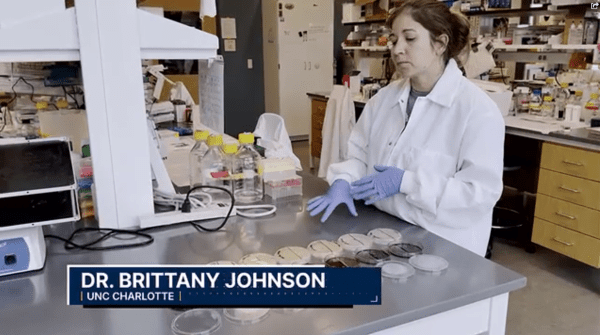WSOC-TV visits the Johnson Lab to uncover how much bacteria is living in reusable water bottles

Although reusable water bottles usually contain less bacteria than plastic water bottles, not cleaning them regularly can lead to exposure to potentially harmful bacteria. WSOC-TV Channel 9’s Erika Jackson visited the lab of Brittany Johnson, Ph.D., assistant professor in the Department of Biological Sciences, to test a variety of reusable water bottles for bacteria.
Johnson swabbed the lids, straws, and insides of the bottles, and then transferred the samples onto two plates that grow two types of microorganisms. The samples were incubated for 48 hours, and then Johnson presented the results, which varied based on how recently the water bottle was used, how often the user washed their bottle, and how thoroughly they washed it.
“As we start going through the water bottles that had been recently used or never washed, you’re going to start to see more and more colonies,” Johnson explained. “The more colonies we see, the more bacteria that was in that sample.”
The bacteria in water bottles can originate from the drinker’s own unique bacteria found in the mouth, but finding foreign bacteria is the most concerning, as it can make people sick.
“When you’re taking your water bottle with you to other places, like you take it with you to the bathroom, then there are germs in the bathroom and bacteria in the bathroom that get on your water bottle,” Johnson said. “Then you ingest those and that can be really harmful.”
Johnson’s findings were also featured on Yahoo!News, Boston 25 News, KIRO 7 News (Seattle), and WFTV (Orlando).
Watch the full segment on WSOC-TV.